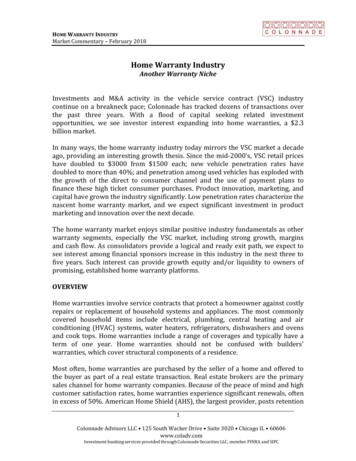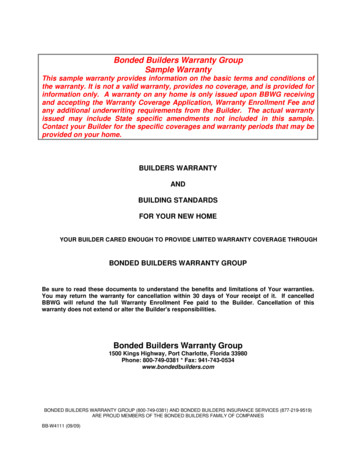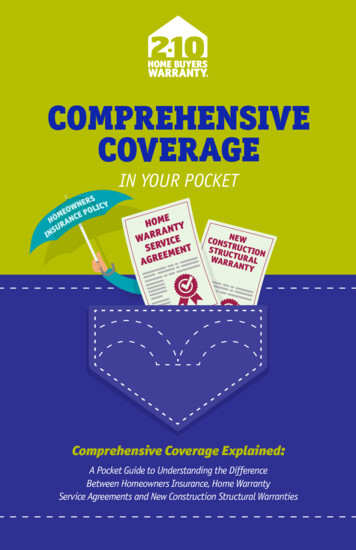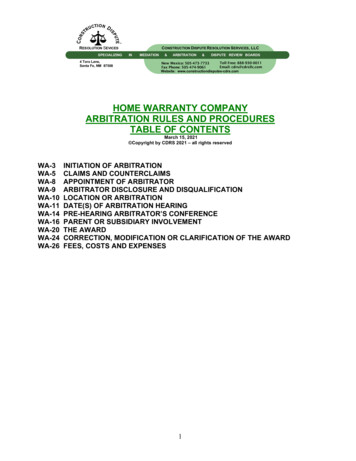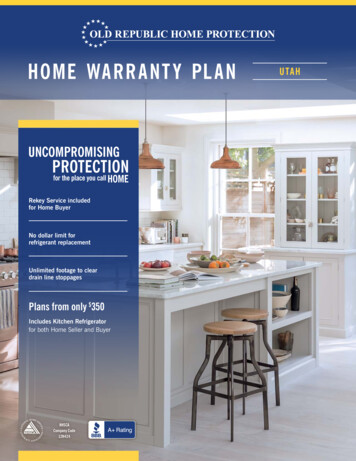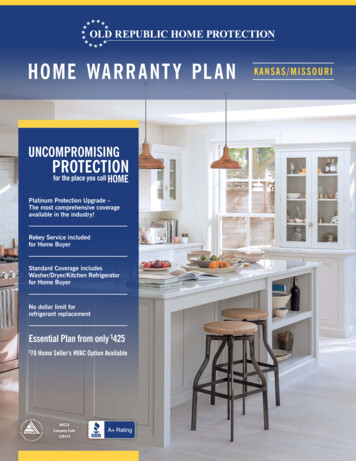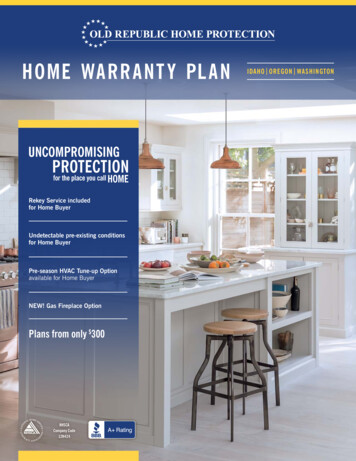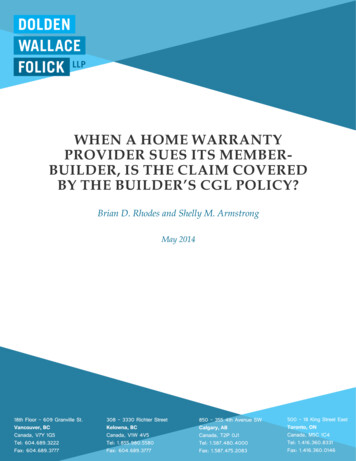
Transcription
WHEN A HOME WARRANTYPROVIDER SUES ITS MEMBERBUILDER, IS THE CLAIM COVEREDBY THE BUILDER’S CGL POLICY?Brian D. Rhodes and Shelly M. ArmstrongMay 2014 Dolden Wallace Folick LLP1
CONTACT LAWYERBrian RhodesShelly 7sarmstrong@dolden.comTABLE OF CONTENTSI.Introduction .2II.Executive Summary .2III.Overview of Home Warranty Programs in Canada .3IV.Ontario’s Home Warranty Model.3V.British Columbia’s Home Warranty Model .4VI.Relevant provisions in the CGL policy .6VII.Relevant caselaw .8VIII.CGL coverage available to a builder: BC versus Ontario.11IX.Conclusion .121 Dolden Wallace Folick LLP
I.INTRODUCTIONThis paper examines an issue which has become increasingly prevalent in Canada in therecent past as more jurisdictions move to implement statutory home warranty regimes.In particular, this paper examines whether a builder faced with a claim by his warrantyinsurance provider is entitled to coverage under his Commercial General Liability(“CGL”) insurance policy. It is our view that the answer to this question depends onthe structure of the home warranty scheme in place. For this reason, we begin ourpaper with a brief overview of home warranty programs across the country. We thenexamine two of the provincial schemes – those in BC and Ontario – in more detail and,with reference to wording in a typical CGL policy, explain how the subtle differences inthese schemes lead us to conclude that, in general, a builder licensed in Ontario will beafforded coverage under his standard CGL policy, whereas a builder licensed in BritishColumbia will not be.II.EXECUTIVE SUMMARYHome warranty schemes in Canada can be classified as “mandatory” or “voluntary”.Both Ontario and BC have “mandatory” home warranty schemes in place. However,the structure of these schemes differs in at least two key respects:1. The Ontario scheme places primary responsibility to repair defectiveworkmanship on the builder whereas the BC scheme places this responsibility ona private third party insurer; and2. The Ontario scheme prescribes performance standards which a builder isrequired to ascribe to whereas the BC scheme does not.As such, in Ontario, builders are “legally obligated” to repair defects thus bringingthem within the language of a typical CGL’s “insuring agreement”. Further, Ontariobuilders’ legal obligation to repair defects is mandated by statue and therefore is notcaught by the “liability assumed by contract” exclusion found in a typical CGL policy.It follows that coverage will typically be afforded to an Ontario builder. In contrast, inBC, any legal obligation to repair defects arises by virtue of an indemnity agreementwith the builder’s warranty provider and not by reason of statute; any claim by thebuilder against its warranty provider would therefore by excluded from coverage undera typical CGL by virtue of the “liability assumed by contract” exclusion. Dolden Wallace Folick LLP2
III.OVERVIEW OF HOME WARRANTY PROGRAMS IN CANADAHome warranty programs are now common-place in the Canadian provinces. Whilethere are as many models of Canadian warranty as there are programs, they all sharecommon principles and features, including:1. a statutory or voluntary warranty obligation;2. a warranty scope that can include housing form, tenure, products, systems,appurtenances, coverage for economic loss, quality and compliance thresholds;3. surety protection for delayed closing, deposits and deficiency completion;4. a term during which an enrolled builder must respond to purchaser requests;and5. the form of warranty whether public, private for-profit, private not-for-profit,self-supply or hybrid.As of the date of this paper, five Canadian provinces have mandatory-statutory homewarranty schemes in place: British Columbia, Quebec, Ontario, Manitoba and, effectiveFebruary 1, 2014, Alberta. Saskatchewan and the Atlantic provinces have voluntaryhome warranty programs in place.As this paper will illustrate with reference to the Ontario and British Columbia homewarranty regimes, subtle but significant differences exist even among the mandatorystatutory home warranty schemes.IV.ONTARIO’S HOME WARRANTY MODELOntario’s home warranty model owes its form to decisions made in the mid-1970’s thatcoincided with the failure of some builders, the introduction of rent control and the firstOntario building code.Ontario’s home warranty program is managed by Tarion Warranty Corporation(“Tarion”), a non-profit, private corporation. Tarion was established in 1976 to protectthe rights of new home buyers and regulate new home builders. As part of its role,Tarion administers the Ontario New Home Warranties Plan Act, R.S.O. 1990, c. 0.31 (the“Ontario Act”), which outlines the warranty protection to which new home purchasersare entitled in Ontario. Anyone in the province of Ontario who plans to build and/orsell a new home must be registered with Tarion and enroll the home(s) as per therequirements in the Ontario Act. Dolden Wallace Folick LLP3
Pursuant to the Ontario Act, builders in Ontario are deemed to provide certainstatutory warranty coverage, including: Protection for deposits; Protection against financial loss for contract homes; Compensation for delays in closing or occupancy; Protection against unauthorized substitutions; One and two year warranties for certain defects in work and materials; A seven year warranty for major structural defects; and Coverage for condominium common elements.The statutorily mandated warranties are backed by Tarion, which in addition toadministering the Act, is responsible for managing a guarantee fund to ensure thatbuilders honour the statutory warranties.A builder’s obligation to repair a warranted defect is triggered on the submission by ahomeowner of a 30-Day, Year-End and/or Second-Year form. If the builder does notcomplete or otherwise resolve items that the homeowner believes are warranted withinthe prescribed time period (120 days), the homeowner then has 30 days to request aTarion “conciliation inspection”. This triggers the start of another 30 day period inwhich the builder may repair or otherwise resolve the warranted items. If the builderfails to do so, Tarion will schedule the requested “conciliation inspection” in thepresence of both the builder and the homeowner and send both a report of the findingswithin 30 days. The builder is given 30 days from the day of the report to resolve thewarranted items. If he does not do so, Tarion will work directly with the homeowner toresolve the items.V.BRITISH COLUMBIA’S HOME WARRANTY MODELBritish Columbia’s home warranty model is a product of the failure of the high-rise andmid-rise condominium construction practices of the 1990’s, and the system of regulationand inspection that was supposed to take place.British Columbia’s home warranty scheme, including its governing legislation, theHomeowners Protection Act, SBC 1998 c. 31 (the “BC Act”) is administered by the Dolden Wallace Folick LLP4
Homeowners Protection Office (“HPO”).1 The BC Act requires that all new homesconstructed with building permits applied for on or after July 1, 1999 be built byresidential builders licensed with the HPO. It also makes third-party home warrantyinsurance mandatory on new home construction throughout the province. Themandatory home warranty insurance can only be obtained from companies that havebeen approved by the Financial Institutions Commission (“FICOM”) and which meetthe requirements of the BC Act.2The BC Act requires, at a minimum, that coverage include: 2 years on labour and materials (some limits apply); 5 years on the building envelope; and 10 years on the structure.The regulation under the BC Act – specifically, the Homeowner Protection Act Regulation,BC Reg 29/99 – sets requirements for how a warranty provider (as opposed to thebuilder) must respond to a properly filed claim. These include: On receipt of a notice of claim from an owner under home warranty insurance,promptly make reasonable attempts to contact the owner to arrange anevaluation of the claim. If, following evaluation of a claim under home warranty insurance, the warrantyprovider determines that the claim is not valid or not covered under the homewarranty insurance, the warranty provider must notify the owner of the decisionin writing, setting out the reasons for the decision. If the claim is found to be valid, repairs must be undertaken in a timely manner,with reasonable consideration given to weather conditions and the availability ofmaterials and labour.Previously, the HPO had crown corporation status; however, in 2010, the HPO lost its crowncorporation status and became a branch of BC Housing.2 The FICOM authorized home warranty insurance companies include: Aviva Insurance Company ofCanada represented by National Home Warranty Group Inc. and Pacific Home Warranty InsuranceService Inc., Echelon General Insurance Company represented by Pacific Home Warranty InsuranceService Inc., RSA represented by WBI Home Warranty Ltd. and Travelers Insurance Company of Canada.1 Dolden Wallace Folick LLP5
All repairs and replacements made under home warranty insurance must bewarranted against defects and labour for at least one year.Pursuant to the BC Act, the warranty provider is ultimately responsible for repairingany construction defects covered by a home warranty insurance policy. That said, inmany cases, the warranty provider will have an indemnity agreement with its memberbuilder (i.e. a contract which obligates the builder to correct defects that are deemed tobe covered by home warranty insurance). This indemnity agreement will also oftenrequire the builder to provide financial security of some sort to their warranty provider.Wording typical of an indemnity agreement between a warranty provider and itsmember-builder is as follows:IndemnityThe Builder agrees, that if it is in default of any obligation to a Purchaser, it shalland does hereby indemnify and save harmless The Program with respect to everycost, expense or payment incurred by The Program which the Program is requiredto make by reason of any obligation imposed by this Agreement or undertaken byThe Program pursuant to the provisions hereof or under the provisions of theLimited Warranty or any assurance issued pursuant thereto including, withoutlimitation, every and all costs which The Program may incur in investigating,negotiating, settling or litigating any claim or with respect to the fees ofconsultants, lawyers and others whom The Program may retain in connection withany claim made against The Program under this Agreement and the LimitedWarranty.Notably, the indemnity provision entitles the warranty provider to indemnification ofits investigative and litigation fees incurred in pursuing indemnity from a roguebuilder, in addition to the expenses incurred to remedy warranted defects which thebuilder failed to address.VI.RELEVANT PROVISIONS IN THE CGL POLICYIn order to determine whether any given claim will trigger coverage under a CGL, it isnecessary to consider the language of the CGL at issue. For the purposes of this paper,we have reproduced below the relevant portions of a typical CGL.(a) Insuring AgreementThe “insuring agreement” in a typical CGL provides as follows: Dolden Wallace Folick LLP6
We will pay those sums that the Insured becomes legally obligated to pay as“compensatory damages” because of “bodily injury” or “property damage” to whichthis insurance applies. No other obligation or liability to pay sums or perform acts orservices is covered unless explicitly provided for under SUPPLEMENTARY PAYMENTS– COVERAGES A, B AND D. This insurance applies only to “bodily injury” and“property damage” which occurs during the form period. The “bodily injury” or“property damage” must be caused by an “occurrence”. The “occurrence” must takeplace in the “coverage territory”. We will have the right and duty to defend any “action”seeking those “compensatory damages” but:1) The amount we will pay for “compensatory damages” is limited as described inSECTION III – LIMITS OF INSURANCE;2) We may investigate and settle any claim or “action” at our discretion; and3) Our right and duty to defend end when we have used up the applicable limit ofinsurance in the payment of judgments or settlements under Coverages A, B or D ormedical expenses under Coverage C.a. “Compensatory damages” because of “bodily injury” include “compensatorydamages” claimed by any person or organization for care, loss or services ordeath resulting at any time from the “bodily injury”.b. “Property damage” that is loss of use of tangible property that is notphysically injured shall be deemed to occur at the time of the “occurrence” thatcaused it.“Compensatory damages” is typically defined in a CGL policy to mean:[D]amage due or awarded in payment for actual injury or economic loss. “Compensatorydamages” does not include punitive or exemplary damages or the multiple portion of anymultiplied damage award.“Property damage” is typically defined in a CGL policy to mean:a.Physical injury to tangible property, including all resulting loss of use of thatproperty; orb.Loss of use of tangible property that is not physically injured.“Occurrence” is commonly defined in a CGL policy to mean: Dolden Wallace Folick LLP7
[A]n accident, including continuous or repeated exposure to substantially the samegeneral harmful conditions. 3(b) Contractual liability exclusionCGL policies often exclude coverage for liability assumed by contract or agreement.Typical wording for this exclusion is as follows:This insurance does not apply to “bodily injury” or “property damage” for which theinsured is obligated to pay “compensatory damages” by reason of the assumption ofliability in a contract or agreement. This exclusion does not apply to liability for“compensatory damages”:1) Assumed in a contract or agreement that is an “insured contract”; or2) That the insured would have in the absence of the contract or agreement”.“Insured contract” may be defined in material part to mean: that part of any other contract or agreement pertaining to your business under whichyou assume the tort liability of another to pay “compensatory damages” because of bodilyinjury or “property damage” to a third person or organization, if the contract or agreementis made prior to the “bodily injury” or “property damage”. Tort liability means a liabilitythat would be imposed by law in the absence of any contract or agreement.VII. RELEVANT CASELAWThe applicability of a builder’s CGL policy to a member-builder’s claim forindemnification from its CGL provider was considered in the Ontario case, BridgewoodBuilding Corp. (Riverfield) v. Lombard General Insurance Co. of Canada., 2005 CanLII 63763(ONSC).In Lombard, a number of homeowners made warranty claims against the residentialbuilder, Bridgewood. Bridgewood funded the repairs and then submitted the claims toits CGL insurer, Lombard General Insurance Company of Canada (“Lombard”) forindemnification. Lombard denied coverage to Bridgewood. Therefore, Bridgewoodsought a determination from the Ontario Superior Court of Justice (“ONSC”) as towhether coverage was available to him for the costs of the repairs under his CGL policy.The CGL policy at issue contained similar provisions to the “typical” CGL wordings setCanadian courts have held that the term “accident” is to be interpreted in its popular and ordinary senseas an “unlooked for mishap or an untoward event which is not expected or designed” (see Mutual ofOmaha Insurance v. Stats [1978] 2 S.C.R. 1153).3 Dolden Wallace Folick LLP8
out above. This gave rise to three issues for determination by the ONSC, two of whichare relevant for our purposes.The two relevant issues for determination in Lombard were:1) Whether the builder was “legally obligated to pay as damages” the repair andassociated costs resulting from the defects at issue so as to bring them within themeaning of policy’s insuring agreement.2) Whether the exclusion for liability “assumed in a contract” contained in the policyapplied to the facts and thereby deprived the builder of coverage.In respect of the first issue, Lombard argued that “legally obligated to pay as damages”requires a determination of liability beyond what had occurred in that case. In its view,“legally obligated to pay as damages” required that there be some demonstrated fault onthe part of the prospective insured, or a determination that they are “legally obligated topay” before liability can be brought to bear. The ONSC rejected this restrictiveinterpretation of the meaning of that provision, agreeing instead with the position of thebuilder, Bridgewood, that the plain meaning of “legally obligated to pay as damages”,construed broadly, embraces the statutorily imposed warranty obligations which werethe subject of the dispute (i.e. the warranties which the Ontario Act deems all buildersto provide). In this regard, Stewart J. cited with approval the following passage fromthe text Commercial General Liability Insurance by Heather A. Sanderson (Toronto:Butterworths, 2000), at pp. 37-38 (at para. 33):Despite some early controversy on this point there is now significant Canadian authorityto the effect that the phrases "liability imposed by law" and "legally obligated to pay"include any liability imposed by a judgment of a court, whether the liability arises out oftort or contract or whether the relief claimed draws on an equitable remedy such asrestitution. A direct statutory obligation to pay amounts to the government can alsoconstitute a "legal obligation to pay" within the meaning of this phrase -- even if theliability is imposed directly and a court's only involvement would be in the case of nonpayment. . . . Given that one is looking at unqualified words in a coverage agreement whicha court is bound to interpret broadly in favour of the insured, it is appropriate to give thephrases "liability imposed by law" and "legally obligated to pay" a wide interpretation.These authorities and principles indicate that an argument that these phrases include allfacets of an insured's civil liability has great weight.In response to Lombard’s assertion that a CGL policy is not meant to be a performancebond and that the CGL policy in question did not extend to provide indemnity for Dolden Wallace Folick LLP9
anything that was not the result of the fault of the insured, Stewart J. commentedfurther as follows (at para. 36):It is evident that the Act and the ONHWP are in the nature of consumer protectionlegislation, designed to assist and protect the purchasers of new homes. In my view, thisno-fault remedial and protective legislative scheme is akin to environmental protectionlegislation which requires pollution clean-up and the costs thereof to be carried out andabsorbed by persons regardless of proof of negligence or fault. Coverage for these attendantcosts has often been considered by courts in the United States [cites omitted]. Since 1990,most courts that have considered costs of cleaning up environmental damage, costsconnected with compliance with the Comprehensive Environmental Response,Compensation, and Liability Act, are covered by the standard language in CGL insuringagreements which pay “all sums which the insured shall become legally obligated to pay asdamages” [cites omitted]. In my view, the same approach should be taken in this particularcase. (our emphasis)In respect of the second issue, Lombard argued that because the Ontario homewarranty legislative regime requires vendors and builders to extend warranty coverageto purchasers of new homes, this represents a liability “assumed in contract” by thebuilder and is therefore not covered by the CGL contract. Again, the ONSC rejectedLombard’s position. Significantly, it found that that the obligations imposed onbuilders by the Ontario home warranty legislation were not “assumed in a contract”, butrather were mandated by statute, and that “failure to comply with those statutoryrequirements would require the builder to ignore their statutorily-imposed duties and jeopardizetheir continued registration to carry on business in Ontario” (at para. 38).In the end, the ONSC granted the builder Bridgewood a declaration that its statutoryobligation pursuant to the Ontario Act to effect the repairs constituted a legal obligationto pay damages within the meaning of the applicable CGL policy and a declaration thatLombard was obligated to indemnify the builder for the repair costs and all reasonableexpenses incurred or to be incurred to compensate the homeowners for losses andexpenses arising from the defects. The ONSC decision was appealed, on differentgrounds. The coverage decision was upheld by the Ontario Court of Appeal, withoutreference to the warranty issue.To our knowledge, the ONSC’s core analysis in Lombard has not been revisited and weare unaware of any other Canadian decision in which a court has considered whether amember-builder subject to a claim from its warranty provider is entitled to coverageunder his CGL policy. We are also unaware of any American decision which directlyaddresses this point. Dolden Wallace Folick LLP10
VIII. CGL COVERAGE AVAILABLE TO A BUILDER: BC VERSUS ONTARIOWhile every case must necessarily be determined on its facts with reference to the exactwording of the applicable policy provisions, it appears that, at least in Ontario, it islikely that a builder will be entitled to coverage under his CGL policy for costs incurreddue to duties of repair imposed on him by the Ontario Act. The question is, does thisextend to British Columbia builders operating under British Columbia’s home warrantyregime? In our view, it does not.As set out above, the Ontario Act reposes builders with certain statutory obligations inrespect of new home construction. In particular, the Ontario Act deems certainstatutorily constituted warranties to be included in every contract of purchase and salebetween a builder and the purchaser of a new home. Further, the Ontario Actprescribes standards which the builder is required to adhere to in order to becomelicensed to build new homes in Ontario. While Tarion backs the obligations andresponsibilities of the builder and will step in if the builder fails to honour hisobligations, primary responsibility to effect the repairs lies with the builder.4In contrast, the BC Act is merely a legislative framework for mandating a homeowner’swarranty. It does not prescribe performance standards that a builder is required toascribe to. Rather, the BC Act prescribes the minimum requirements that must becovered by warranty and contains a general requirement that the form of private thirdparty insurance be approved by the HPO then leaves the specifics to be determined bythe FICOM-approved warranty providers (insurers). It is true that the warrantyprovider can (and often will) enter into an indemnity agreement with the builderentitling it to sue the builder to recover its costs if the builder’s work turns out to bedefective (including the costs it incurs in investigating, negotiating, settling or litigatingits claim). However, unlike the situation in Ontario, under the applicable legislation,ultimate responsibility for ensuring the minimum warranty requirements are metresides with the warranty provider, not the builder. Any right of recovery on the partof the warranty provider arises by virtue of its contractual agreement with the builder;it is not a right prescribed by statute.In our view, the indemnity agreement between warranty provider and its memberbuilder is an agreement assumed by contract and, as a result, a warranty provider’sclaim against a builder brought pursuant thereto would most likely be excluded fromcoverage under a typical CGL policy by virtue of the contractual liability exclusion.The Ontario Act does give Tarion the right, upon paying a homeowner’s claim, to sue the builderalleging a breach of the statutorily mandated performance standards. Such a claim would be a breach ofcontract claim for failure to adhere to the prescriptive performance standards (not to recover on acontractual indemnity).4 Dolden Wallace Folick LLP11
This conclusion stems at least in part from the fact that an indemnity agreement, by itsvery terms, obligates a builder to pay more than merely the cost of repairing a homebut, as well, the private insurer’s expenses in adjusting the loss and engaging in legalproceedings (i.e., unlike the statutory warranty in Ontario, it does not necessarilyprecisely “mirror” the exposure of the underlying warranties mandated by statute).Further, it is our view that an indemnity that seeks recovery of more than merelycompensatory amounts (as do most builder indemnity agreements), is not, by its nature“compensatory” and, as such, may not even fall within the wording of a typical CGLpolicy’s insuring agreement.For these reasons, it is our view that, in most cases a BC member-builder will not beentitled to coverage under his CGL policy if he is sued by his warranty provider. Werepeat, however, that this is a generalization and that every case will need to be decidedwith reference to the specific facts and the applicable policy wordings.IX.CONCLUSIONAs more Canadian jurisdictions move towards implementation of home warrantyregimes, we expect that CGL insurance providers will encounter the issues raised in thispaper with increasing frequency. When faced with a claim from a builder and thecorresponding need to make a determination on coverage, it will be important for theCGL insurer to bear in mind that the coverage determination will be influenced bymany factors, not the least of which is the structure of the home warranty program inthe relevant jurisdiction. Even the most subtle differences in structure can change theoutcome of the coverage determination. Dolden Wallace Folick LLP12
statutory home warranty schemes. IV. ONTARIO'S HOME WARRANTY MODEL Ontario's home warranty model owes its form to decisions made in the mid-1970's that coincided with the failure of some builders, the introduction of rent control and the first Ontario building code. Ontario's home warranty program is managed by Tarion Warranty Corporation
